A Framework for the Characterization of Aviation Construction Projects: The Case of UAE
Abstract
:1. Introduction
2. Literature Review
2.1. Impact of AI on Project Management
2.2. Aviation Project Management

2.3. Challenges in Aviation Construction Projects
- Ongoing or expected expansion and renewal projects: These types of projects are driven by the significant and escalating growth in the number of passengers, particularly within airport environments.
- Tied time schedule requirements: Due to the traffic caused by the passengers and the various numbers of flights per day, the operations are critical, and the projects should be completed within the specified duration without any delays.
- Variety of stakeholders: indicating the huge number of stakeholders and the different requirements based on the specifications set by the General Civil Aviation Authority (GCAA).
- Wide variety of activities and functions: according to which the design concept and specification of the projects should be produced and prepared before the construction process.
- Special systems and specifications: This reflects the number of systems used in the airport, such as security devices, electrical systems, firefighting, and alarm systems. Such systems are an additional level of complication to the design and construction process.
- Economic returns from the sector: The aviation industry adds USD 19.3 billion to the Gross Domestic Product (GDP) of the UAE [22].
- Security: The level of security systems is very important and should be put at the highest level.
- Significance of the country: UAE is one of the most well-developed countries in the world, particularly in the Middle East, which serves as a hub between the East and the West.
2.4. Applications of AI in Aviation Construction Projects
2.4.1. AI in Gate Design and Allocation
2.4.2. AI in Airport Security Functions
2.4.3. AI in Predictive Maintenance
3. Research Objectives
- Gather the needed data from the existing literature and real case projects to identify the features that characterize construction projects with a focus on the aviation sector.
- Develop a model that utilizes AI tools to match new airport construction projects with similar existing ones and group projects based on their complexities, similarities, and differences.
- Use neural networks to determine the best number of clusters that identify the projects without sacrificing the contrast between the individual projects.
- Validate the proposed model via real projects in order to form better decisions by looking at similar practices.
- AI-Driven Analysis: Utilizes AI tools to evaluate and group aviation construction projects, enhancing analysis and efficiency.
- Neural Network Clustering: Employs neural networks to determine optimal project clusters, ensuring precise categorization.
- Context-Specific Framework: Develops a tailored framework for the UAE’s aviation sector, offering region-specific insights and practical solutions.
4. Research Methodology
4.1. Hierarchical Clustering (HC)
4.2. Artificial Neural Network (ANN)
5. The Attributes of Aviation Construction Projects
- -
- Attribute Collection: Initially, 42 attributes related to aviation and airport construction projects were gathered from the literature and author-designed surveys.
- -
- Inclusion/Exclusion Criteria: A set of criteria was applied to filter these attributes, aiming to identify the most relevant ones for the projects in question. This process involved assessing the relevance and applicability of each attribute (e.g., some of the attributes were very specific, unique, and could not be applicable for all ACPs).
- -
- Final Selection: After applying the criteria, 31 attributes were selected as the most applicable for accurately describing aviation construction projects. The final set of attributes and their description are illustrated in Table 1.
6. Classification Model
7. Data Analysis and Results
8. Implications
9. Conclusions
Author Contributions
Funding
Data Availability Statement
Conflicts of Interest
Appendix A
| Design and Technology | The Level of the Risk | |||||||||||||||||||||||||||||||
| Contract Title | Contractual Duration (in Days) | Actual Duration (in Days) | Peak Manpower | Design Duration (in Days) | Project Size | Project Complexity Level | Location | Safety Requirements | The Project Involved Utilizing Building Information Modeling (BIM) for Design and Construction | Level of Technology Integration in the Project | Implementation of Building Management System (BMS) | Technical/Operational Risks | Environmental Risks | Management Related Risks | Requirement of Consultant | Cost/Budget | Sustainability | the Number of Different Engineering Trades/Disciplines Required | Closure Needed or Not | Diversion of Roads | Current Stage | Stakeholders Approval | Back-Up Power Arrangements | Requirement of Long Lead Items | Project Scope Definition | Design from Scratch | Amendments on Existing Design | level of Interior Design | Survey Requirements | Level of Accessibility | Facility Type | |
| Project #1 | 360.00 | 630.00 | 170 | 766 | 1 | 3 | 0 | 3 | 1 | 1 | 1 | 3 | 1 | 2 | 1 | 4 | 3 | 2 | 0 | 1 | 2 | 1 | 1 | 1 | 3 | 0 | 1 | 1 | 1 | 2 | 3 | |
| Project #2 | 251.00 | 524.00 | 49 | 509 | 1 | 1 | 1 | 3 | 0 | 1 | 0 | 3 | 3 | 2 | 1 | 2 | 3 | 1 | 0 | 0 | 2 | 0 | 0 | 0 | 2 | 0 | 0 | 2 | 1 | 1 | 3 | |
| Project #3 | 209.00 | 598.00 | 51 | 576 | 1 | 2 | 1 | 2 | 0 | 1 | 1 | 3 | 3 | 1 | 1 | 2 | 3 | 2 | 1 | 0 | 2 | 1 | 1 | 0 | 2 | 0 | 0 | 1 | 1 | 1 | 3 | |
| Project #4 | 378.00 | 909.00 | 131 | 239 | 1 | 3 | 0 | 3 | 1 | 2 | 1 | 2 | 2 | 3 | 1 | 4 | 3 | 4 | 1 | 1 | 1 | 1 | 1 | 1 | 3 | 0 | 1 | 1 | 1 | 3 | 3 | |
| Project #5 | 144.00 | 144.00 | 38 | 0 | 1 | 1 | 0 | 1 | 0 | 3 | 0 | 1 | 1 | 1 | 0 | 2 | 1 | 4 | 1 | 0 | 2 | 0 | 0 | 0 | 3 | 1 | 0 | 3 | 1 | 3 | 3 | |
| Project #6 | 155.00 | 235.00 | 7 | 0 | 0 | 1 | 0 | 1 | 0 | 1 | 0 | 1 | 1 | 1 | 0 | 1 | 2 | 3 | 0 | 0 | 2 | 0 | 0 | 0 | 4 | 0 | 1 | 3 | 0 | 2 | 3 | |
| Project #7 | 263.00 | 263.00 | 30 | 126 | 1 | 3 | 0 | 1 | 0 | 3 | 1 | 1 | 1 | 1 | 1 | 3 | 3 | 4 | 1 | 0 | 2 | 0 | 0 | 0 | 3 | 1 | 0 | 3 | 1 | 3 | 3 | |
| Project #8 | 424.00 | 530.00 | 25 | 39 | 1 | 3 | 0 | 1 | 0 | 2 | 1 | 1 | 1 | 1 | 1 | 3 | 1 | 3 | 1 | 0 | 1 | 0 | 0 | 0 | 3 | 1 | 0 | 1 | 1 | 3 | 2 | |
| Project #9 | 659.00 | 671.00 | 17 | 1030 | 1 | 2 | 0 | 3 | 0 | 2 | 1 | 3 | 2 | 1 | 1 | 2 | 3 | 2 | 0 | 0 | 2 | 1 | 1 | 1 | 1 | 0 | 0 | 1 | 1 | 2 | 0 | |
| Project #10 | 786.00 | 606.00 | 4 | 86 | 1 | 3 | 1 | 1 | 0 | 2 | 0 | 2 | 1 | 1 | 1 | 2 | 3 | 2 | 1 | 0 | 2 | 0 | 0 | 1 | 1 | 0 | 1 | 1 | 1 | 1 | 5 | |
| Project #11 | 1045.00 | 1395.00 | 50 | 1089 | 0 | 3 | 0 | 3 | 0 | 3 | 1 | 3 | 2 | 2 | 1 | 3 | 3 | 2 | 0 | 0 | 1 | 1 | 1 | 0 | 1 | 0 | 1 | 1 | 1 | 3 | 4 | |
| Project #12 | 560.00 | 560.00 | 47 | 805 | 0 | 2 | 0 | 1 | 1 | 2 | 1 | 3 | 1 | 2 | 1 | 2 | 3 | 4 | 0 | 0 | 2 | 0 | 0 | 0 | 1 | 0 | 1 | 1 | 1 | 3 | 1 | |
| Project #13 | 209.00 | 209.00 | 25 | 326 | 0 | 1 | 0 | 2 | 0 | 2 | 0 | 1 | 1 | 1 | 1 | 1 | 3 | 4 | 1 | 1 | 1 | 0 | 0 | 0 | 3 | 0 | 1 | 3 | 0 | 1 | 2 | |
| Project #14 | 419.00 | 1193.00 | 20 | 519 | 1 | 2 | 0 | 3 | 0 | 1 | 1 | 3 | 1 | 2 | 1 | 3 | 3 | 1 | 0 | 0 | 2 | 1 | 1 | 1 | 3 | 0 | 1 | 1 | 1 | 3 | 0 | |
| Project #15 | 397.00 | 1406.00 | 26 | 142 | 1 | 2 | 0 | 3 | 0 | 1 | 1 | 3 | 1 | 2 | 1 | 4 | 3 | 2 | 0 | 0 | 1 | 1 | 1 | 1 | 1 | 0 | 1 | 1 | 1 | 2 | 0 | |
| Project #16 | 299.00 | 645.00 | 14 | 103 | 1 | 2 | 0 | 2 | 0 | 1 | 1 | 2 | 1 | 1 | 1 | 2 | 3 | 3 | 1 | 0 | 2 | 1 | 0 | 0 | 1 | 0 | 0 | 1 | 1 | 2 | 0 | |
| Project #17 | 283.00 | 518.00 | 50 | 825 | 1 | 3 | 1 | 1 | 0 | 2 | 1 | 2 | 1 | 2 | 1 | 2 | 2 | 3 | 1 | 1 | 2 | 1 | 1 | 0 | 1 | 0 | 0 | 1 | 1 | 3 | 0 | |
| Project #18 | 299.00 | 517.00 | 18 | 514 | 1 | 2 | 0 | 3 | 0 | 2 | 1 | 3 | 2 | 3 | 1 | 3 | 3 | 2 | 1 | 1 | 1 | 0 | 0 | 0 | 3 | 0 | 0 | 1 | 0 | 3 | 0 | |
| Project #19 | 879.00 | 879.00 | 82 | 1000 | 1 | 2 | 0 | 3 | 0 | 2 | 1 | 3 | 1 | 2 | 1 | 4 | 3 | 2 | 0 | 0 | 1 | 1 | 1 | 1 | 1 | 0 | 1 | 1 | 1 | 3 | 0 | |
| Project #20 | 885.00 | 852.00 | 9 | 401 | 1 | 1 | 1 | 2 | 0 | 1 | 0 | 2 | 1 | 1 | 1 | 2 | 3 | 2 | 1 | 0 | 1 | 0 | 0 | 1 | 1 | 0 | 0 | 1 | 1 | 2 | 5 | |
References
- Tengan, C.; Aigbavboa, C.; Thwala, W.D. Construction Project Monitoring and Evaluation: An Integrated Approach; Routledge: New York, NY, USA, 2021; pp. 3–11. [Google Scholar]
- Radujković, M.; Sjekavica, M. Project management success factors. Procedia Eng. 2017, 196, 607–615. [Google Scholar] [CrossRef]
- Odejide, O.A.; Edunjobi, T.E. AI in project management: Exploring theoretical models for decision-making and risk management. Eng. Sci. Technol. J. 2024, 5, 1072–1085. [Google Scholar] [CrossRef]
- Belharet, A.; Bharathan, U.; Dzingina, B.; Madhavan, N.; Mathur, C.; Toti, Y.D.B.; Babbar, D.; Markowski, K. Report on the Impact of Artificial Intelligence on Project Management. Mach. Learn. eJ. 2020. [Google Scholar] [CrossRef]
- Hofmann, P.; Jöhnk, J.; Protschky, D.; Urbach, N. Developing Purposeful AI Use Cases-A Structured Method and Its Application in Project Management. In Proceedings of the Wirtschaftsinformatik (Zentrale Tracks), Potsdam, Germany, 9–11 March 2020; pp. 33–49. [Google Scholar]
- Shamim, M.M.I. Artificial Intelligence in Project Management: Enhancing Efficiency and Decision-Making. Int. J. Manag. Inf. Syst. Data Sci. 2024, 1, 1–6. [Google Scholar]
- Schuh, G.; Hicking, J.; Stroh, M.F.; Benning, J. Using AI to Facilitate Technology Management–Designing an Automated Technology Radar. Procedia CIRP 2020, 93, 419–424. [Google Scholar] [CrossRef]
- Pan, Y.; Zhang, L. Roles of artificial intelligence in construction engineering and management: A critical review and future trends. Autom. Constr. 2021, 122, 103517. [Google Scholar] [CrossRef]
- Ochuba, N.A.; Okafor, E.S.; Akinrinola, O.; Usman, F.O.; Amoo, O.O. Strategic partnerships in the satellite and telecommunications sectors: A conceptual review of data analytics-enabled identification and capitalization of synergies. Eng. Sci. Technol. J. 2024, 5, 716–727. [Google Scholar] [CrossRef]
- Bang, S.; Olsson, N. Artificial Intelligence in Construction Projects: A Systematic Scoping Review. J. Eng. Proj. Prod. Manag. 2022, 12, 224–238. [Google Scholar]
- Reis, O.; Eneh, N.E.; Ehimuan, B.; Anyanwu, A.; Olorunsogo, T.; Abrahams, T.O. Privacy law challenges in the digital age: A global review of legislation and enforcement. Int. J. Appl. Res. Soc. Sci. 2024, 6, 73–88. [Google Scholar] [CrossRef]
- Dwivedi, Y.K.; Hughes, L.; Ismagilova, E.; Aarts, G.; Coombs, C.; Crick, T.; Duan, Y.; Dwivedi, R.; Edwards, J.; Eirug, A.; et al. Artificial Intelligence (AI): Multidisciplinary perspectives on emerging challenges, opportunities, and agenda for research, practice and policy. Int. J. Inf. Manag. 2021, 57, 101994. [Google Scholar] [CrossRef]
- Nenni, M.E.; De Felice, F.; De Luca, C.; Forcina, A. How artificial intelligence will transform project management in the age of digitization: A systematic literature review. Manag. Rev. Q. 2024, 1–48. [Google Scholar] [CrossRef]
- Asfoor, H.M.A.; AL-Jandeel, A.A.T.; Igorevich, K.K.; Ivanovna, L.A. Control of Time, Cost and Quality of Construction Project Management. E3S Web Conf. 2022, 336, 00072. [Google Scholar] [CrossRef]
- Flouris, T.G.; Lock, D. Aviation Project Management; Routledge: New York, NY, USA, 2016. [Google Scholar]
- Nusraningrum, D.; Priyono, J. Analysis of Cost Control, Time, and Quality on Construction Project. J. Manag. Bus. 2018, 17, 19–30. [Google Scholar] [CrossRef]
- Khalef, R.; El-adaway, I.H. Automated identification of substantial changes in construction projects of airport improvement program: Machine learning and natural language processing comparative analysis. J. Manag. Eng. 2021, 37, 04021062. [Google Scholar] [CrossRef]
- Al-Ghzawi, M.; El-Rayes, K. Machine learning for predicting the impact of construction activities on air traffic operations during airport expansion projects. Autom. Constr. 2024, 158, 105189. [Google Scholar] [CrossRef]
- Huang, Z.; Cheng, Y.; Zhang, D.; Yan, D.; Shen, Y. Seismic fragility and resilience assessment of shallowly buried large-section underground civil defense structure in soft soils: Framework and application. Tunn. Undergr. Space Technol. 2024, 146, 105640. [Google Scholar] [CrossRef]
- Pollack, J.; Helm, J.; Adler, D. What is the Iron Triangle, and how has it changed? Int. J. Manag. Proj. Bus. 2018, 11, 527–547. [Google Scholar] [CrossRef]
- Shakya, S.; Mishra, A.K. Risk assessment in construction of Gautam Buddha International Airport. J. Adv. Res. Constr. Urban Archit. 2019, 4, 17–34. [Google Scholar]
- IATA. The Importance of Air Transport to United Arab Emirates. Available online: https://www.iata.org/en/iata-repository/publications/economic-reports/united-arab-emirates--value-of-aviation/ (accessed on 15 September 2023).
- Datta, S.D.; Islam, M.; Sobuz, M.H.R.; Ahmed, S.; Kar, M. Artificial intelligence and machine learning applications in the project lifecycle of the construction industry: A comprehensive review. Heliyon 2024, 10, e26888. [Google Scholar] [CrossRef]
- Mousa, A. AI/Artificial Intelligent in Aviation Beyond COVID 19. Acta Sci. Comput. Sci. 2021, 3, 11–12. [Google Scholar]
- Sadou, A.M.; Njoya, E.T. Applications of Artificial Intelligence in the Air Transport Industry: A Bibliometric and Systematic Literature Review. J. Aerosp. Technol. Manag. 2023, 15, e2223. [Google Scholar] [CrossRef]
- Kabashkin, I.; Misnevs, B.; Zervina, O. Artificial Intelligence in Aviation: New Professionals for New Technologies. Appl. Sci. 2023, 13, 11660. [Google Scholar] [CrossRef]
- Kashyap, R. Artificial intelligence systems in aviation. In Cases on Modern Computer Systems in Aviation; IGI Global: Hershey, PA, USA, 2019; pp. 1–26. [Google Scholar]
- Rajapaksha, A.; Jayasuriya, N. Smart airport: A review on future of the airport operation. Glob. J. Manag. Bus. Res. 2020, 20, 25–34. [Google Scholar] [CrossRef]
- Patel, K. Ethical reflections on data-centric AI: Balancing benefits and risks. Int. J. Artif. Intell. Res. Dev. 2024, 2, 1–17. [Google Scholar]
- Kamel, H. Artificial intelligence for predictive maintenance. J. Phys. Conf. Ser. 2022, 2299, 012001. [Google Scholar] [CrossRef]
- Daniyan, I.; Mpofu, K.; Oyesola, M.; Ramatsetse, B.; Adeodu, A. Artificial intelligence for predictive maintenance in the railcar learning factories. Procedia Manuf. 2020, 45, 13–18. [Google Scholar] [CrossRef]
- Carvalho, T.P.; Soares, F.A.; Vita, R.; Francisco, R.D.P.; Basto, J.P.; Alcalá, S.G. A systematic literature review of machine learning methods applied to predictive maintenance. Comput. Ind. Eng. 2019, 137, 106024. [Google Scholar] [CrossRef]
- Lin, C.-L.; Fan, C.-L.; Chen, B.-K. Hybrid Analytic Hierarchy Process–Artificial Neural Network Model for Predicting the Major Risks and Quality of Taiwanese Construction Projects. Appl. Sci. 2022, 12, 7790. [Google Scholar] [CrossRef]
- Pérez-Campuzano, D.; Ortega, P.M.; Andrada, L.R.; López-Lázaro, A. Artificial Intelligence potential within airlines: A review on how AI can enhance strategic decision-making in times of COVID-19. J. Airl. Airpt. Manag. 2021, 11, 53–72. [Google Scholar] [CrossRef]
- Nasteski, V. An overview of the supervised machine learning methods. Horiz. B 2017, 4, 51–62. [Google Scholar] [CrossRef]
- Rodriguez, M.Z.; Comin, C.H.; Casanova, D.; Bruno, O.M.; Amancio, D.R.; Costa, L.D.F.; Rodrigues, F.A. Clustering algorithms: A comparative approach. PLoS ONE 2019, 14, e0210236. [Google Scholar] [CrossRef] [PubMed]
- Henry, D.; Dymnicki, A.B.; Mohatt, N.; Allen, J.; Kelly, J.G. Clustering methods with qualitative data: A mixed-methods approach for prevention research with small samples. Prev. Sci. 2015, 16, 1007–1016. [Google Scholar] [CrossRef] [PubMed]
- Mohamed, H.; Negm, A.; Zahran, M.; Saavedra, O.C. Assessment of artificial neural network for bathymetry estimation using high resolution satellite imagery in shallow lakes: Case study El Burullus Lake. In Proceedings of the International Water Technology Conference, ElSheikh, Egypt, 12–14 March 2015; pp. 12–14. [Google Scholar]

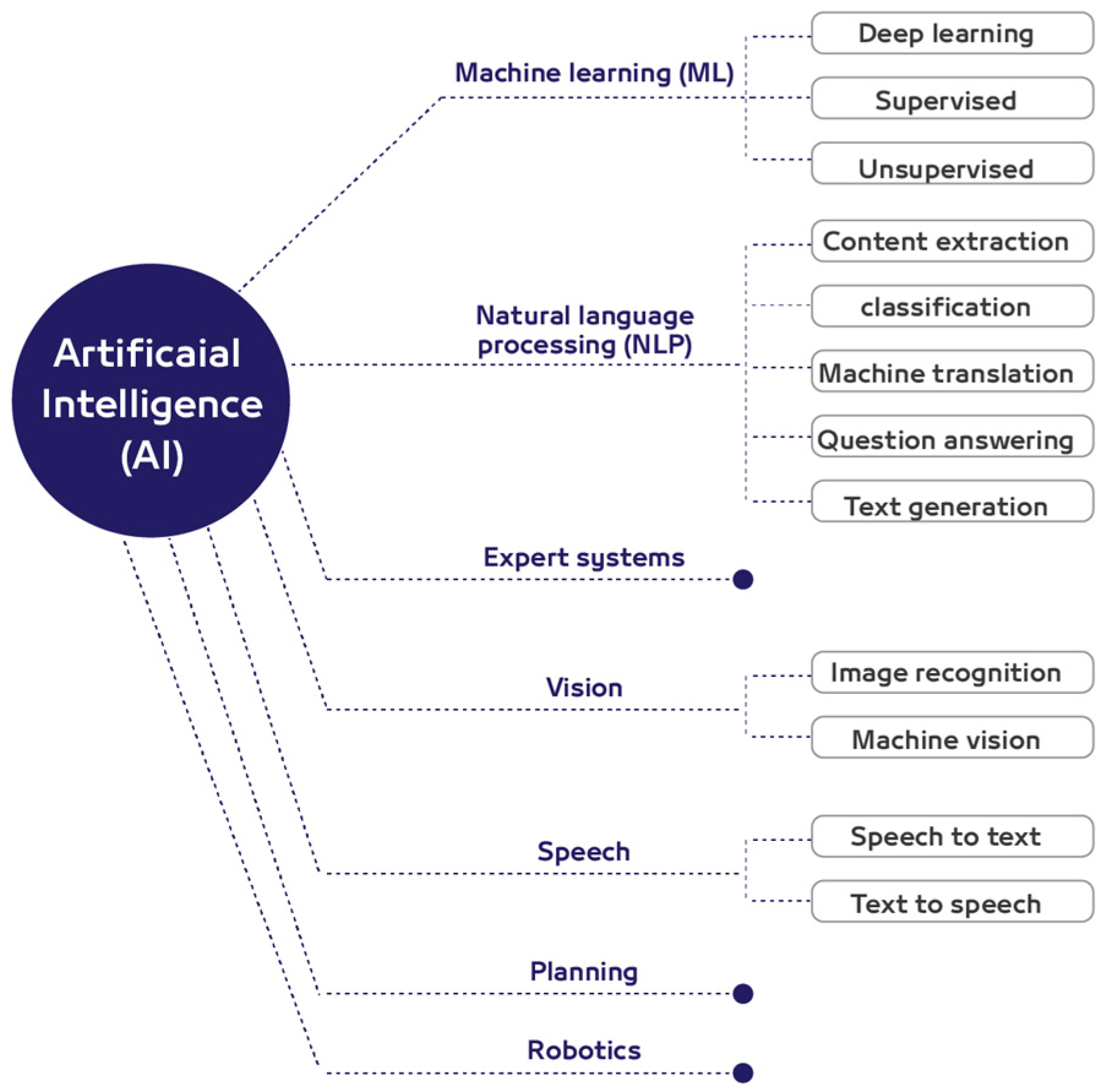
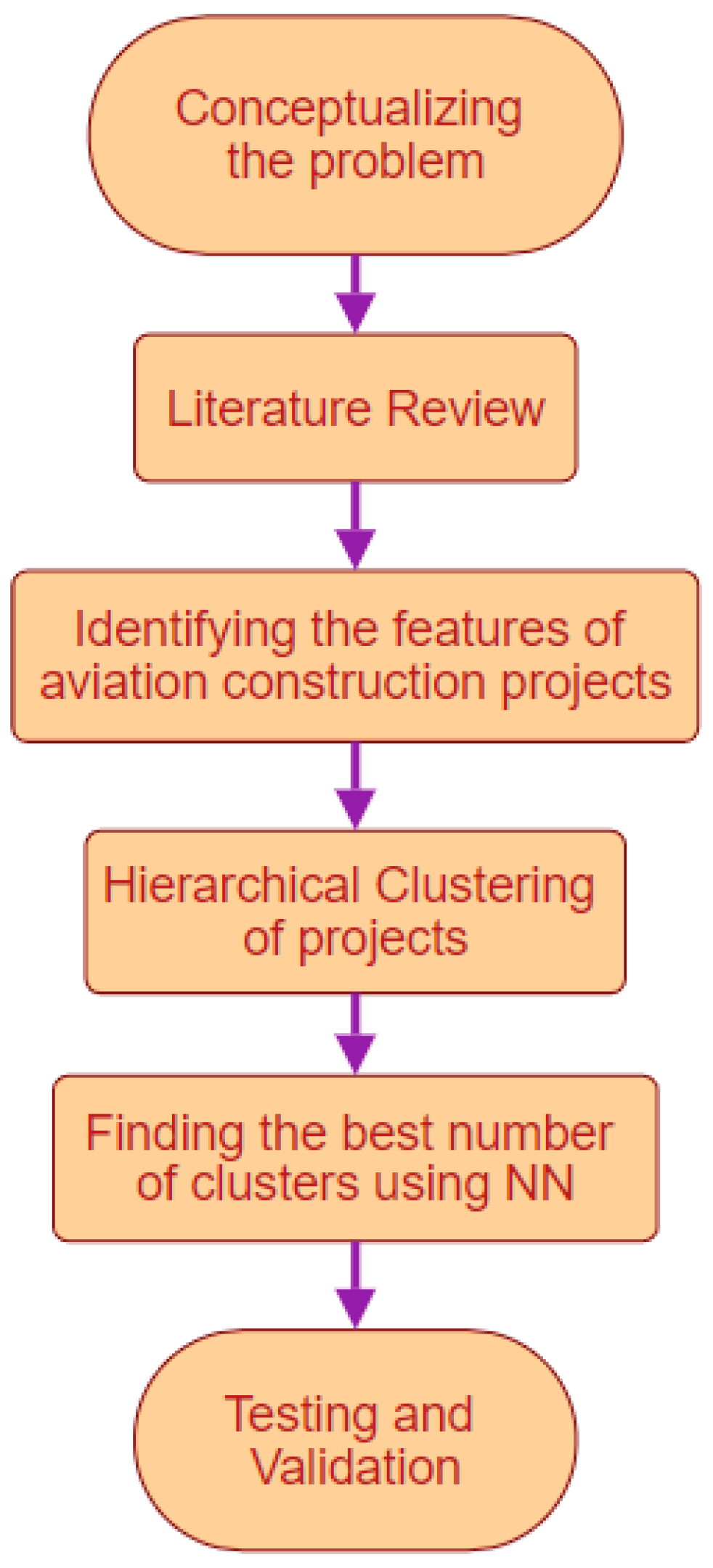

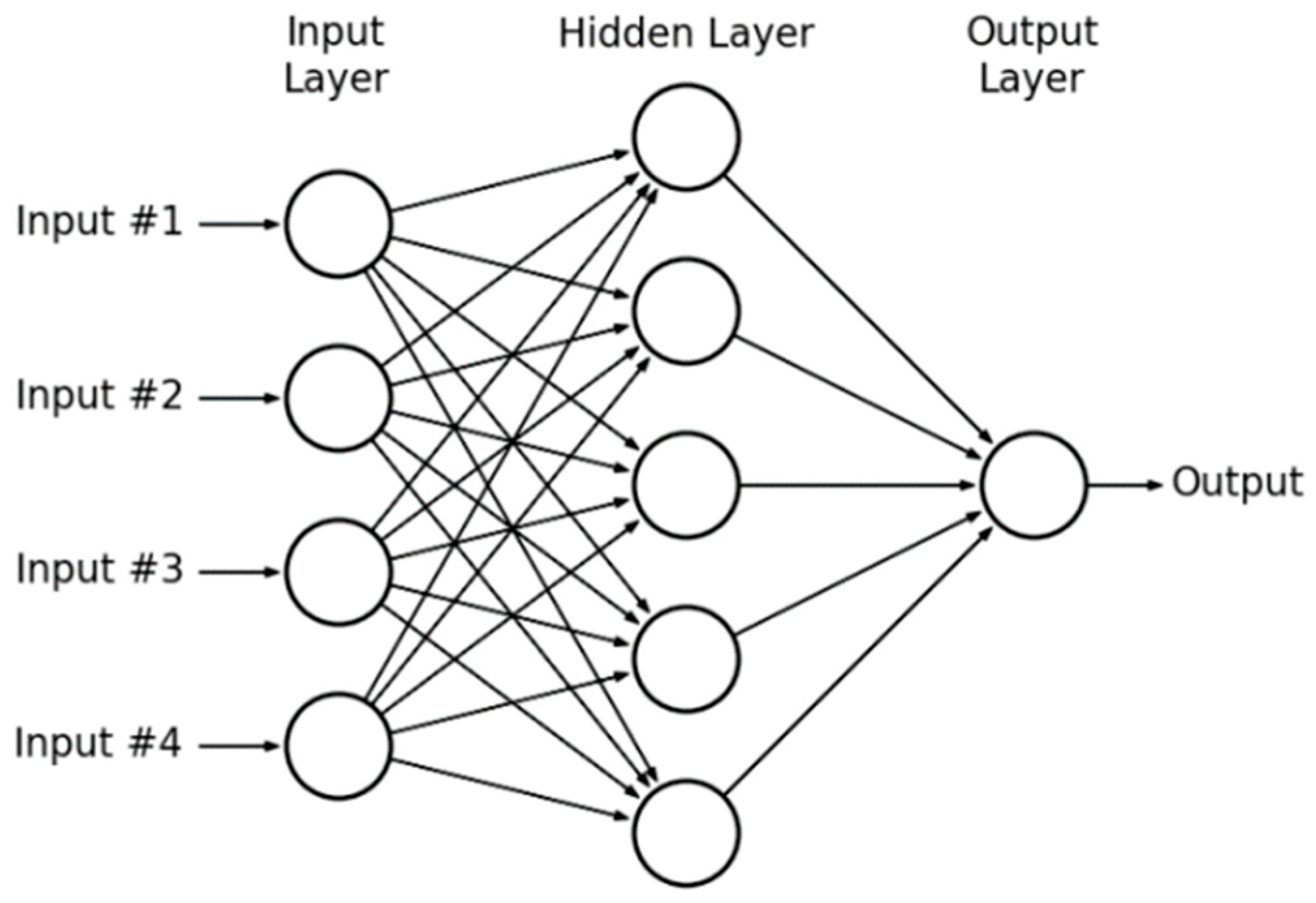
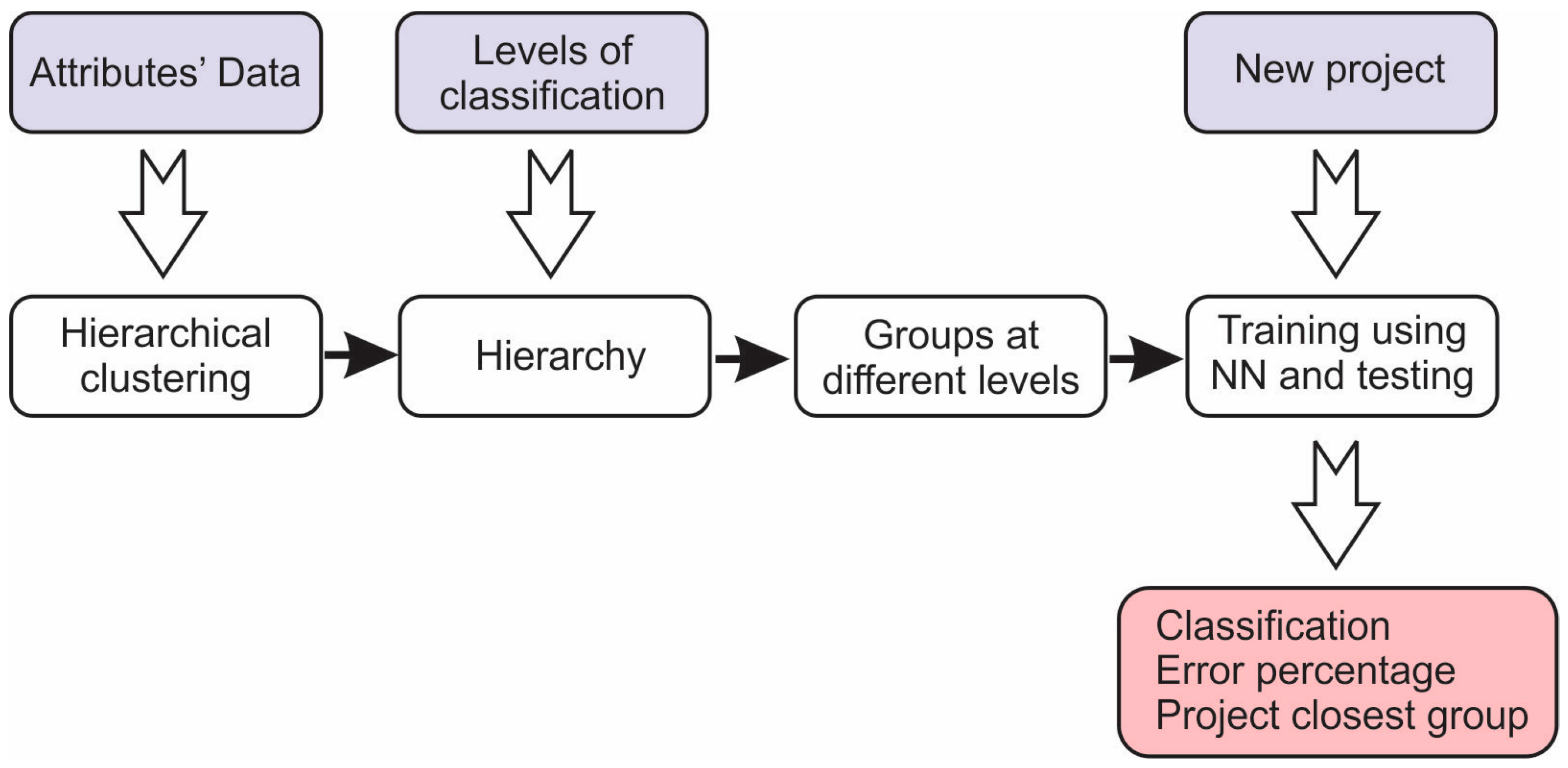
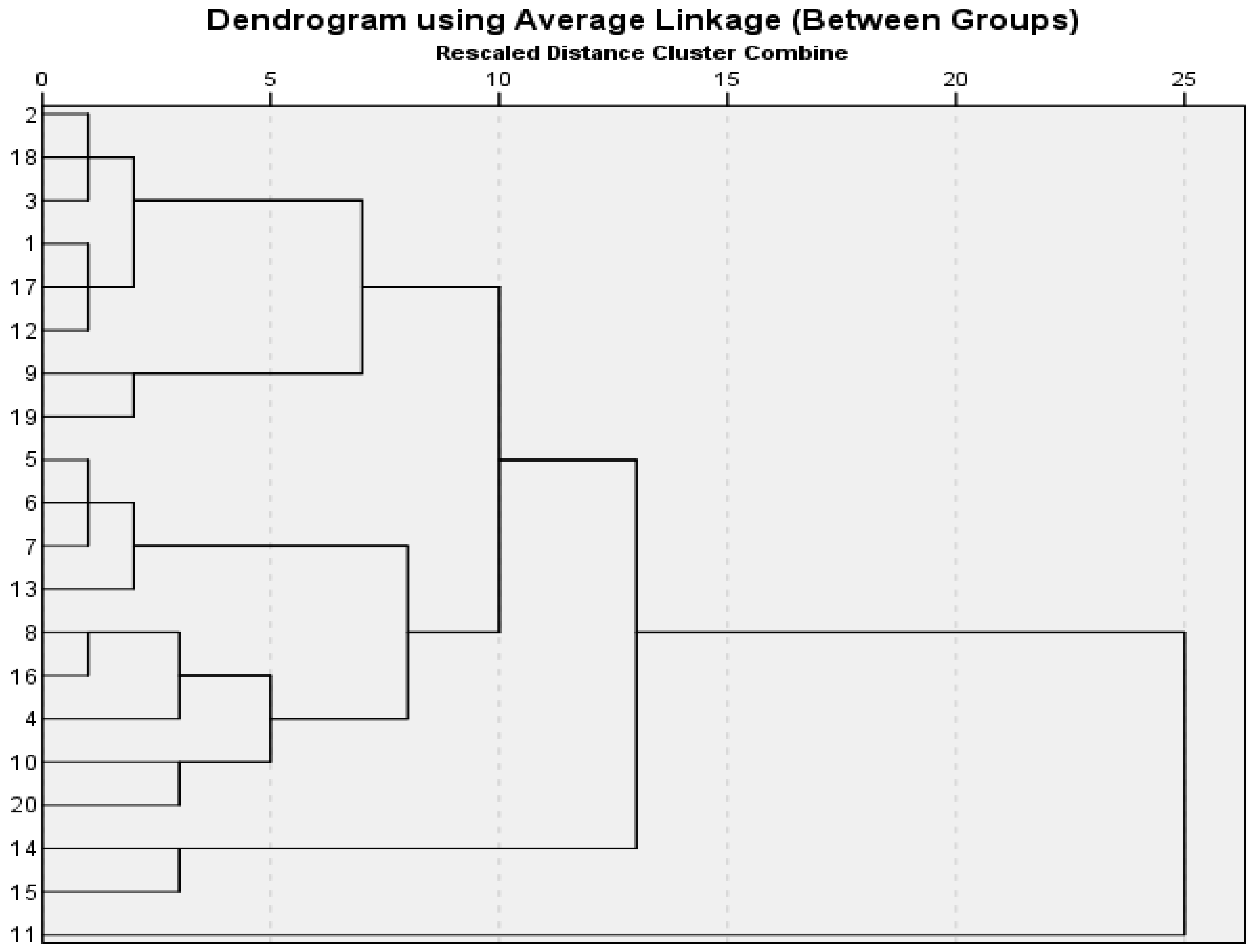

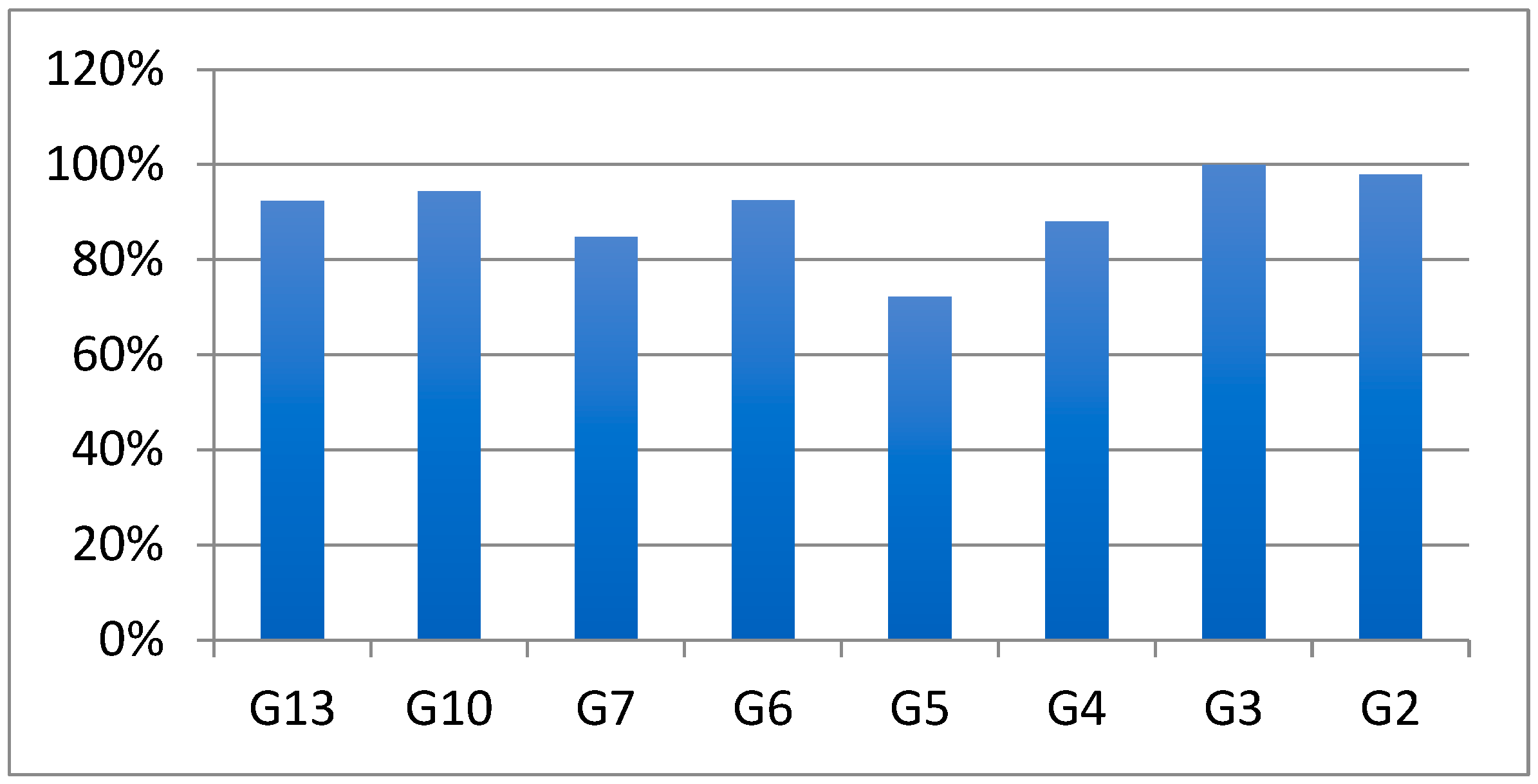
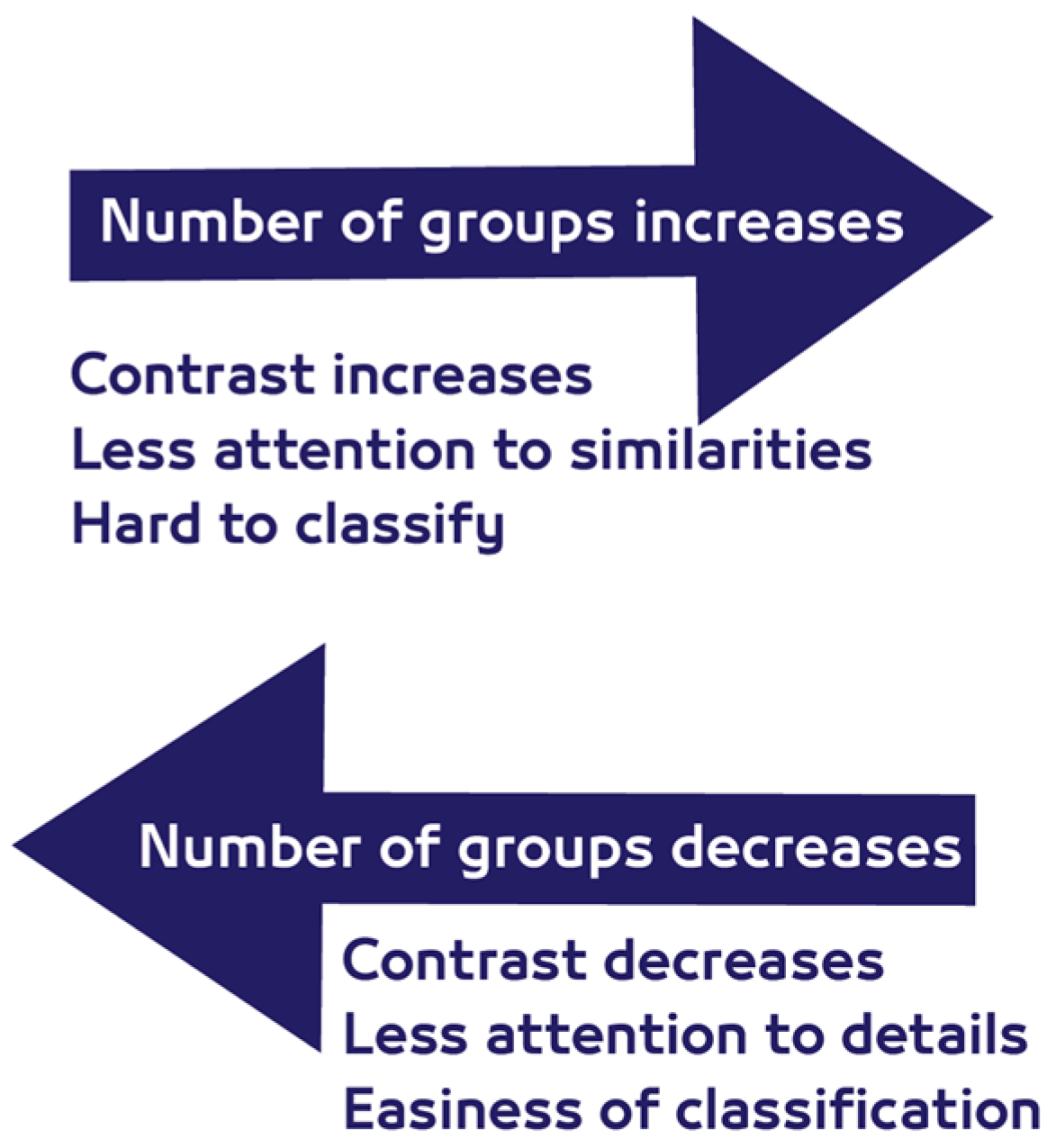
| Attributes | Measures/PI Project’s Indicators |
|---|---|
| Project size | Project size refers to the scale of a project, quantified based on its application within a single or multiple regions, providing a comprehensive assessment of its geographical reach and scope. |
| Design duration | The period required for the design phase, measured in days. |
| Planned Construction duration | The anticipated time frame for construction as outlined in the project plan, measured in days. |
| Actual construction duration | The real time span taken for construction, measured in days. |
| Project complexity level | In project management, the term “complexity of projects” refers to the complicated and multidimensional nature of the activities, objectives, and variables that are part of a project. Determining the complexity level of a project involves assessing various factors that contribute to its overall complexity, in terms of high, medium, and low. |
| Location | Indicated by “Indoor” or “Outdoor” |
| Sustainability | There are various sustainable design principles that could be considered in the projects in order to ensure that these projects are environment friendly and efficient. In this attribute, the projects will be divided as follows: 1. Environmental Sustainability, 2. Social Responsibility, 3. Economic Viability. |
| Project Scope definition | Four categories will be defined for this indicator, as follows:
|
| Design from scratch | A binary indicator that determines if the scope of work includes redesign from scratch |
| Amendments on existing design | Determine if the scope of work is only modifications on the existing one. |
| Level of interior design required | The level of interior design in airport construction projects can vary based on factors such as budget constraints, project objectives, targeted users, and overall design vision. This indicator will be measured in terms of high level, medium level, and low level based on the required level of interior modifications in these projects. |
| The project involves utilizing Building Information Modelling (BIM) for design and construction | BIM reflects digitally the detailed building (3D computer model). It provides an indication of any conflicts and clashes before starting the real construction work. This model helps spot and fix problems at early stages, saving time and money. This can be measured by the binary variable (Yes or No). |
| Level of technology integration in the project | Percentage of digital technologies integrated into airport operations. Examples include installing automated baggage-handling systems, self-check-in kiosks, and smart boarding gates to enhance passenger experience and efficiency. This indicator will be measured in terms of high level, moderate level, and low level of technology. |
| Implementation of Building Management system (BMS) | The Building Management System (BMS) functions as the control center, overseeing various aspects such as heating, lighting, and security. This can be measured by the binary variable (Yes or No). |
| Facility/Project Type | This includes the following categories:
|
| Safety requirements | The level of safety requirements in airport construction projects, whether they fall under high, moderate, or low safety requirements. |
| Back-up power arrangements | Since the operations in the airport are critical, some areas require an alternative power source on a temporary basis until the project or the related work is done. This indicator of back-up power arrangements is provided in terms of “Yes” or “No”. |
| Number of labor/workers | The number of workers assigned for the respective project. |
| Requirement of Closure | Indicates whether the construction project requires partial or complete closure of airport facilities or operational areas during the construction phase, which is given in terms of “Yes” or “No”. |
| Requirement of road diversion | Evaluate if the construction project requires diversion or rerouting of roads or access routes near the area of application which can be measured by the binary variable (Yes or No). |
| Technical/Operational risks |
|
| Environmental Risks |
|
| Management related risks |
|
| Level of Accessibility Restrictions | Measures the level of accessibility in airport construction projects, which typically involves evaluating the ease of access for different stakeholders, such as passengers, airport staff, and construction personnel, to various areas within the airport in terms of Highly Restricted Accessibility, Moderately Restricted Accessibility, and Adequate Accessibility. |
| Requirement of consultant | Almost all projects need a consultant to work with the client and report the progress or any issues within the life cycle of project. However, some projects could be consulted by the client, along with the contractor, according to the scope and size of the project. This can be measured by the binary variable (“Yes” or “No”). |
| Cost/budget | This indicator will reflect the cost associated with the airport construction projects in terms of very low, low, moderate, high, and very high. |
| Current project stage |
|
| The number of different engineering disciplines required | It is a number that reflects the engineering trades that are involved in the project. This includes all related Civil/Architectural, Mechanical, Electrical, IT, Security Works, and others. In this indicator, the measure will be the number of trades/disciplines involved in the respective project. |
| Requirement of long lead items | Long lead items are components or materials that require a longer lead time for procurement or fabrication, often due to their specialized nature or limited availability. |
| Survey requirements | Some projects need to be surveyed and assessed before starting the work in order to report the current status of the area and the applicability of the scope of work. This can be measured by the binary variable (“Yes” or “No”). |
| Stakeholders’ Approval | This indicator reflects the need of any shutdown permits that might affect some system, depending on the scope of the assigned project. |
| Design and Technology | |||||||||||
|---|---|---|---|---|---|---|---|---|---|---|---|
| Contract Title | Contractual Duration (in Days) | Actual Duration (in Days) | Peak Manpower | Design Duration (in Days) | Project Size | Project Complexity Level | Location | Safety Requirements | the Project Involved Utilizing (BIM) for Design and Construction | Level of Technology Integration | Implementation of Building Management System (BMS) |
| Project #1 | 360 | 630 | 170 | 766 | 1 | 3 | 0 | 3 | 1 | 1 | 1 |
| Project #2 | 251 | 524 | 49 | 509 | 1 | 1 | 1 | 3 | 0 | 1 | 0 |
| Project #3 | 209 | 598 | 51 | 576 | 1 | 2 | 1 | 2 | 0 | 1 | 1 |
| Project #4 | 378 | 909 | 131 | 239 | 1 | 3 | 0 | 3 | 1 | 2 | 1 |
| Project #5 | 144 | 144 | 38 | 0 | 1 | 1 | 0 | 1 | 0 | 3 | 0 |
| Project #6 | 155 | 235 | 7 | 0 | 0 | 1 | 0 | 1 | 0 | 1 | 0 |
| Project #7 | 263 | 263 | 30 | 126 | 1 | 3 | 0 | 1 | 0 | 3 | 1 |
| Project #8 | 424 | 530 | 25 | 39 | 1 | 3 | 0 | 1 | 0 | 2 | 1 |
| Project #9 | 659 | 671 | 17 | 1030 | 1 | 2 | 0 | 3 | 0 | 2 | 1 |
| Project #10 | 786 | 606 | 4 | 86 | 1 | 3 | 1 | 1 | 0 | 2 | 0 |
| Project #11 | 1045 | 1395 | 50 | 1089 | 0 | 3 | 0 | 3 | 0 | 3 | 1 |
| Project #12 | 560 | 560 | 47 | 805 | 0 | 2 | 0 | 1 | 1 | 2 | 1 |
| Project #13 | 209 | 209 | 25 | 326 | 0 | 1 | 0 | 2 | 0 | 2 | 0 |
| Project #14 | 419 | 1193 | 20 | 519 | 1 | 2 | 0 | 3 | 0 | 1 | 1 |
| Project #15 | 397 | 1406 | 26 | 142 | 1 | 2 | 0 | 3 | 0 | 1 | 1 |
| Project #16 | 299 | 645 | 14 | 103 | 1 | 2 | 0 | 2 | 0 | 1 | 1 |
| Project #17 | 283 | 518 | 50 | 825 | 1 | 3 | 1 | 1 | 0 | 2 | 1 |
| Project #18 | 299 | 517 | 18 | 514 | 1 | 2 | 0 | 3 | 0 | 2 | 1 |
| Project #19 | 879 | 879 | 82 | 1000 | 1 | 2 | 0 | 3 | 0 | 2 | 1 |
| Project #20 | 885 | 852 | 9 | 401 | 1 | 1 | 1 | 2 | 0 | 1 | 0 |
| Clusters at Different Levels | |||||||||
|---|---|---|---|---|---|---|---|---|---|
| Project No. | L1 | L2 | L3 | L4 | L5 | L6 | L7 | L8 | L9 |
| 1 | 17 | 2 | 1 | 1 | 1 | 1 | 1 | 1 | 1 |
| 2 | 20 | 1 | 1 | 1 | 1 | 1 | 1 | 1 | 1 |
| 3 | 18 | 1 | 1 | 1 | 1 | 1 | 1 | 1 | 1 |
| 4 | 6 | 8 | 5 | 4 | 4 | 3 | 2 | 1 | 1 |
| 5 | 12 | 5 | 3 | 3 | 3 | 2 | 2 | 1 | 1 |
| 6 | 11 | 5 | 3 | 3 | 3 | 2 | 2 | 1 | 1 |
| 7 | 10 | 5 | 3 | 3 | 3 | 2 | 2 | 1 | 1 |
| 8 | 8 | 7 | 4 | 4 | 4 | 3 | 2 | 1 | 1 |
| 9 | 14 | 3 | 2 | 2 | 2 | 1 | 1 | 1 | 1 |
| 10 | 5 | 9 | 6 | 5 | 4 | 3 | 2 | 1 | 1 |
| 11 | 1 | 13 | 10 | 7 | 6 | 5 | 4 | 3 | 2 |
| 12 | 15 | 2 | 1 | 1 | 1 | 1 | 1 | 1 | 1 |
| 13 | 9 | 6 | 3 | 3 | 3 | 2 | 2 | 1 | 1 |
| 14 | 3 | 11 | 8 | 6 | 5 | 4 | 3 | 2 | 1 |
| 15 | 2 | 12 | 9 | 6 | 5 | 4 | 3 | 2 | 1 |
| 16 | 7 | 7 | 4 | 4 | 4 | 3 | 2 | 1 | 1 |
| 17 | 16 | 2 | 1 | 1 | 1 | 1 | 1 | 1 | 1 |
| 18 | 19 | 1 | 1 | 1 | 1 | 1 | 1 | 1 | 1 |
| 19 | 13 | 4 | 2 | 2 | 2 | 1 | 1 | 1 | 1 |
| 20 | 4 | 10 | 7 | 5 | 4 | 3 | 2 | 1 | 1 |
| No. of groups | 20 | 13 | 10 | 7 | 6 | 5 | 4 | 3 | 2 |
| No. of Groups | Training to Testing Ratio | Average | ||||||
|---|---|---|---|---|---|---|---|---|
| 18-2 | 15-5 | 10-10 | 5-15 | 14-6 | 13-7 | 12-8 | ||
| G20 * | N/A | N/A | N/A | N/A | N/A | N/A | N/A | N/A |
| G13 | 66.7% | 100% | 80% | 100% | 100% | 100% | 100% | 92% |
| G10 | 100% | 75% | 85.70% | 100% | 100% | 100% | 100% | 94% |
| G7 | 100% | 100% | 100% | 60% | 66.70% | 100% | 66.70% | 85% |
| G6 | 100% | 100% | 87.50% | 100% | 100% | 100% | 60% | 93% |
| G5 | 50% | 80% | 60% | 80% | 50% | 100% | 85.70% | 72% |
| G4 | 100% | 75% | 66.70% | 100% | 85.70% | 88.90% | 100% | 88% |
| G3 | 100% | 100% | 100% | 100% | 100% | 100% | 100% | 100% |
| G2 | 100% | 100% | 100% | 85.70% | 100% | 100% | 100% | 98% |
Disclaimer/Publisher’s Note: The statements, opinions and data contained in all publications are solely those of the individual author(s) and contributor(s) and not of MDPI and/or the editor(s). MDPI and/or the editor(s) disclaim responsibility for any injury to people or property resulting from any ideas, methods, instructions or products referred to in the content. |
© 2024 by the authors. Licensee MDPI, Basel, Switzerland. This article is an open access article distributed under the terms and conditions of the Creative Commons Attribution (CC BY) license (https://creativecommons.org/licenses/by/4.0/).
Share and Cite
Alketbi, M.A.; Dalalah, D.; Dweiri, F. A Framework for the Characterization of Aviation Construction Projects: The Case of UAE. Buildings 2024, 14, 2384. https://doi.org/10.3390/buildings14082384
Alketbi MA, Dalalah D, Dweiri F. A Framework for the Characterization of Aviation Construction Projects: The Case of UAE. Buildings. 2024; 14(8):2384. https://doi.org/10.3390/buildings14082384
Chicago/Turabian StyleAlketbi, Mariam Abdalla, Doraid Dalalah, and Fikri Dweiri. 2024. "A Framework for the Characterization of Aviation Construction Projects: The Case of UAE" Buildings 14, no. 8: 2384. https://doi.org/10.3390/buildings14082384
APA StyleAlketbi, M. A., Dalalah, D., & Dweiri, F. (2024). A Framework for the Characterization of Aviation Construction Projects: The Case of UAE. Buildings, 14(8), 2384. https://doi.org/10.3390/buildings14082384






